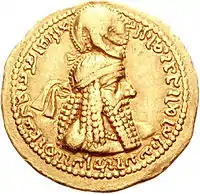Diadem
A diadem is a type of crown, specifically an ornamental headband worn by monarchs and others as a badge of royalty.



Overview
The word derives from the Greek διάδημα diádēma, "band" or "fillet",[1] from διαδέω diadéō, "I bind round", or "I fasten".[2] The term originally referred to the embroidered white silk ribbon, ending in a knot and two fringed strips often draped over the shoulders, that surrounded the head of the king to denote his authority. Such ribbons were also used to crown victorious athletes in important sports games in antiquity. It was later applied to a metal crown, generally in a circular or "fillet" shape. For example, the crown worn by Queen Juliana of the Netherlands was a diadem, as was that of a baron later (in some countries surmounted by three globes). The ancient Celts were believed to have used a thin, semioval gold plate called a mind (Old Irish) as a diadem.[3] Some of the earliest examples of these types of crowns can be found in ancient Egypt, from the simple fabric type to the more elaborate metallic type, and in the Aegean world.[4]
A diadem is also a jewelled ornament in the shape of a half crown, worn by women and placed over the forehead (in this sense, also called tiara). In some societies, it may be a wreath worn around the head. The ancient Persians wore a high and erect royal tiara encircled with a diadem. Hera, queen of the Greek gods, wore a golden crown called the diadem.
The "Priest King" statue made by the Indus Valley civilization (c. 3300 – c. 1300 BCE) wore a headband that is possibly a diadem.[5][6]
By extension, "diadem" can be used generally for an emblem of regal power or dignity. The Roman emperor's head regalia worn, from the time of Diocletian onwards, is described as a diadem in the original sources. It was this object that the Foederatus general Odoacer returned to Emperor Zeno (the emperor of the Eastern Roman Empire) after his expulsion of the usurper Romulus Augustus from Rome in 476 AD.
Gallery
.jpg.webp)
.jpg.webp) 17th Dynasty diadem crown (Rijksmuseum van Oudheden)
17th Dynasty diadem crown (Rijksmuseum van Oudheden) 19th Dynasty wig with diadem (British Museum)
19th Dynasty wig with diadem (British Museum)
 Diodotus of Bactria wearing the diadema, a white ribbon which was the Hellenistic symbol of kingship
Diodotus of Bactria wearing the diadema, a white ribbon which was the Hellenistic symbol of kingship The centerpiece of this Hellenistic diadem is a Herakles knot, known for its apotropaic powers and its status as a symbol of fertility. Walters Art Museum, c. 3rd – 2nd century BC.
The centerpiece of this Hellenistic diadem is a Herakles knot, known for its apotropaic powers and its status as a symbol of fertility. Walters Art Museum, c. 3rd – 2nd century BC. Gold diadem. Greek, probably made in Alexandria, Egypt, and belonging to a noblewoman of the Ptolemaic dynasty (220–100 BC): the clasp is shaped as a Herakles knot
Gold diadem. Greek, probably made in Alexandria, Egypt, and belonging to a noblewoman of the Ptolemaic dynasty (220–100 BC): the clasp is shaped as a Herakles knot Drachma of Mithridates I of Parthia, showing him wearing a beard and a royal diadem on his head
Drachma of Mithridates I of Parthia, showing him wearing a beard and a royal diadem on his head Greco-Roman bust of a woman wearing a diadem (100 BC – 100 AD)
Greco-Roman bust of a woman wearing a diadem (100 BC – 100 AD) Imperial diadem as worn by Eastern Christian Roman emperors from the 4th century onward
Imperial diadem as worn by Eastern Christian Roman emperors from the 4th century onward Bracelet made from a diadem with the addition of two foliate elements (c. 1870, Walters Art Museum)
Bracelet made from a diadem with the addition of two foliate elements (c. 1870, Walters Art Museum) Ardashir I of Sassanian Persia wearing very elaborate diadems
Ardashir I of Sassanian Persia wearing very elaborate diadems
See also
References
- διάδημα, Henry George Liddell, Robert Scott, A Greek-English Lexicon, on Perseus Digital Library
- διαδέω, Henry George Liddell, Robert Scott, A Greek-English Lexicon, on Perseus Digital Library
- William Dwight Whitney, The Century dictionary; an encyclopedic lexicon of the English language. New York: The Century Company (1889), page 3,772. Google Book Search.
- Revello, Manuela, “The first aegean jewellery (4500-1800 B.C.): a new attempt at gold and silver diadems classification”, in Archaeometallurgy in Europe, International Conference Proceedings, Milan 24-25–26 September 2003, II, 657- 664
- "'Priest King,' Mohenjo-daro | Harappa".
- "'Priest King' Forehead | Harappa".
External links
- Diadem at Livius.org
- Diadem at Everything2.com
.svg.png.webp)